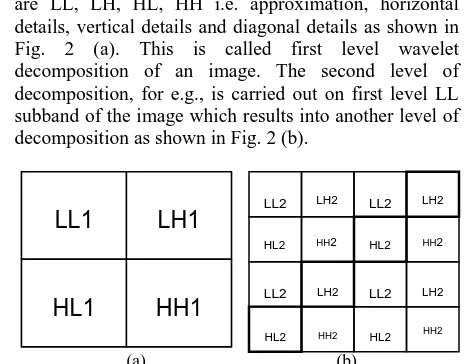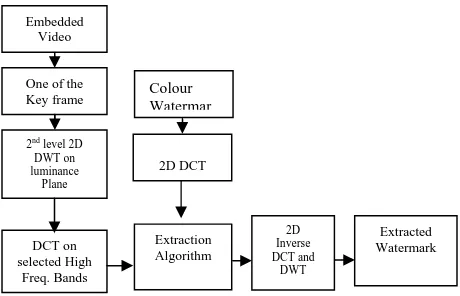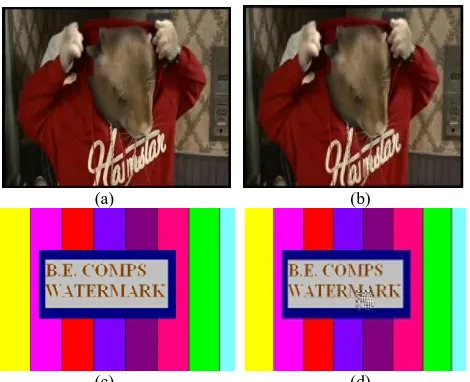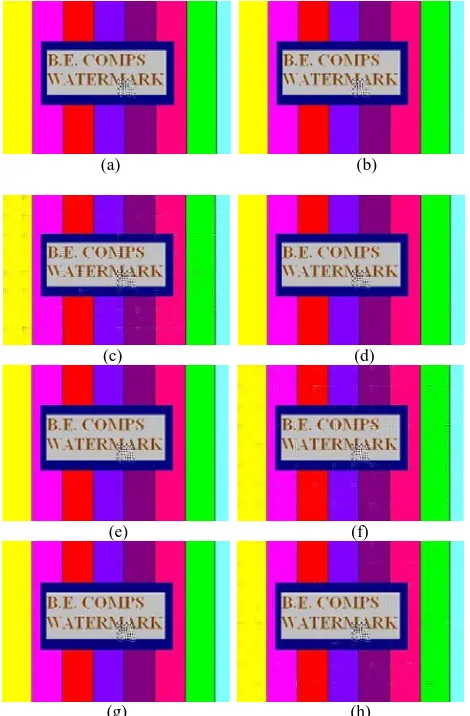A Robust Video Watermarking Scheme using
DWT and DCT
Aditi Agarwal1, Ruchika Bhadana2 and Satishkumar Chavan3
1,2Department of Computer Engineering, 3Department of Electronics & Telecommunication Engineering,
Don Bosco Institute of Technology, Kurla (W), Mumbai-400070 India
Abstract:
Digital data is easily available in the form of images and videos, over the internet. Consequently, the increased importance of digital content invites new challenges for securing the distribution of digital media. This paper addresses a unique, robust copyright protection scheme for videos. In this watermarking algorithm, the video frames are selected randomly from the reference frames of original host video. The embedding of digital signature, tag or data is carried out in the frequency domain. The high frequency bands i.e. LH and HL in the wavelet domain are selected on which DCT is applied. The mid frequency coefficients of these DCT coefficients are altered by low frequency coefficients of the watermark to be embedded. The watermark can be retrieved from the watermarked video by randomly selecting any reference frame. The proposed algorithm is more secure, robust and efficient because of use of DWT and DCT. The algorithm uses the HL and LH bands to add the watermark where the motion does not affect the quality of extracted watermark even if the video is subjected to different types of malicious attacks. The technique is tested for various attacks and stands out to be fairly acceptable and robust against a wide range of signal and video processing operations. The embedded video is of good quality with high PSNR. The technique shows efficient extraction of watermark with high PSNR of the retrieved watermark.
Keyword:Frequency Domain, Spatial Domain, Wavelets, Video Watermarking, DWT, DCT.
1.
I
NTRODUCTIONThere has been a tremendous hike in the amount of information being used from the Internet. This has led to an increase in the amount of information being available on the Internet. Due to this ever growing usage of multimedia content on the Internet, serious issues have been marked. Counterfeiting, forgery, fraud, and pirating of this content are most common amongst these issues. Consequently, copyright abuse is taking a toll among multimedia users who are rarely caught.
This copyright abuse is the motivating factor in developing new technologies like digital image and video watermarking. Video watermarking deals with the watermarking process for videos. A need for video watermarking arose due to the fact that most of the information online these days is in the form of videos as well.Most of the watermarking techniques presented so far were utilizing monochrome or gray images as watermark. Now a day, it is necessary to have a technique which will embed color watermark because various organizations are using color images as their logos. Various video
watermarking methodologies were presented in [1].The proposed method serves the purpose of providing authenticity and copyright protection of videos using color watermark. The novelty of the proposed algorithm is color watermark being embedded into a video in an invisible manner. The method uses a combination of Discrete Wavelet Transform (DWT) and Discrete Cosine Transform (DCT). The DWT is first applied twice on the selected video frames and then block wise DCT is applied on high frequency components of these multiresolved frames. These high frequency coefficients are altered by DCT low frequency coefficients of color watermark. It is complicated and high computational method which has robustness against various signal and video processing attacks. It proves efficient and fairly robust technique against various attacks leading to good quality watermarked videos with high PSNR values of the watermarked video frames as well as the retrieved watermark.
The organization of the paper is as follows: Literature survey is given in section 2. A brief introduction to DCT and DWT along with its relevance to proposed algorithms is presented in section 3. Section 4 describes the proposed scheme with watermark embedding and extraction algorithms for invisible color watermark in a video. Finally, experimental results and discussions on the performance of proposed scheme are depicted in section 5 followed by applications of watermarking in section 6 and Conclusion on the proposed scheme in section 7.
2.
L
ITERATURES
URVEYThe proposed paper involves use of two most popular frequency domain techniques Discrete Wavelet Transform (DWT) and Discrete Cosine Transform (DCT) for video watermarking. DCT is popularly used in watermarking techniques for identifying low frequency, high energy content in images [15]. DWT is a very attractive transform because of its efficient spatial localization,frequency spread and multi-resolution [16]. The combined DWT-DCT methods were implemented in [17] which embed monochrome and/or gray scale watermark into gray scale host image. The DWT-DCT method of color image watermarking is implemented in [13].
frames is carried out followed by DCT applied on the high frequency coefficients of these DWT coefficients. The color watermark is converted into appropriate luminance plane on which blockwise DCT is applied and low frequency DCT coefficients are embedded into high frequency coefficients of the host video frame. The method is a non-blind watermarking technique.
3.
T
HED
CTA
NDD
WTT
RANSFORMSThe DCT and DWT transforms are very much popular in the application of watermarking. In this section, DCT and DWT transforms are briefly described.
A. The DCT transform: The DCT [10] provides a good
compromise between information packing ability and computational complexity. The most important energy compaction property of DCT is extensively used to represents an image. The DCT coefficients for output C(u,v) are computed for the input image f(x,y) using Equation 1 where f(x,y) is M x N image having M rows and N columns and C(u,v) is the DCT coefficients arranged in M x N matrix.
where, 2 ) 1 2 ( 2 ) 1 2 ( ) , ( ) , ( 1 0 1 0 N v y Cos M u x Cos y x f v u C M u N v v u
…(1)
N M α
α u v
2 1
0 0 v u v u
The reconstruction of the image from the DCT coefficients is carried out by applying inverse DCT using Equation 2 which is given below:
N v y Cos M u x Cos v u C N M y x f v M u N v u 2 ) 1 2 ( 2 ) 1 2 ( ) , ( 2 2 ) , ( 1 0 1 0
... (2)DCT transform is normally applied on block of 8x8 non-overlapping image segments. It provides three frequency bands: low frequency band, mid-frequency sub-band and high frequency sub-sub-band as shown in Fig. 1. In proposed algorithm DCT is applied on the high frequency DWT coefficients of host video frames and mid frequency DCT coefficients are altered by low frequency DCT coefficients of watermark image. This is carried out because much of the signal energy lies at low-frequency sub-band which contains the most important visual contents of the image and high frequencycomponents of the image may be usually removed through compression and noise attacks. The watermark is therefore embedded by modifying the coefficients of the middle frequency sub-band so that the visibility and quality of the host video will not be affected and the watermark will not be removed by attacks.
Fig. 1 Frequency subbands in DCT block coefficients (Green color: low frequency subband, Red color: mid frequency
subband, White color: high frequency subband)
B. The DWT transform:Multiresolution property of DWT
helps in decomposition of images. The image is passed through various orthonormal filters like Daubechies, QMFs etc. so that the image gets divided into four non-overlapping multiresolution sub-bands. These subbands are LL, LH, HL, HH i.e. approximation, horizontal details, vertical details and diagonal details as shown in Fig. 2 (a). This is called first level wavelet decomposition of an image. The second level of decomposition, for e.g., is carried out on first level LL subband of the image which results into another level of decomposition as shown in Fig. 2 (b).
(a) (b)
Fig. 2 Wavelet Decomposition (a) First level decomposition (b) Second level decomposition (the highlighted high frequency bands
are used to embed watermark)
DWT provides excellent spatio-frequency localization. Most of the image energy is concentrated in the lower frequency sub-bands (LL) while details like sharpness, edges etc. of the images are present in high frequency subbands (LH, HL and HH). Therefore watermark is embedded in high frequency subbands to avoid degradation of the host video and make it invisible. But embedding watermark in high frequency subbands may reduce robustness. To get best tradeoff between performance and robustness, watermark is embedded into LH and HL subbands. In the proposed algorithm, a second level DWT decomposition is applied and then blockwise DCT is applied on the LH and HL planes before embedding the watermark. The watermark is embedded in the LH2 and HL2 subbands of LH and HL subbands of the first level decomposition. It improves the robustness of the algorithm and it helps in increased capacity of embedding data.
LL1
LH1
HL1
HH1
LL2 LH2
HL2 HH2
LL2 LH2
HL2 HH2
LL2 LH2
HL2 HH2
LL2 LH2
4.
P
ROPOSEDM
ETHODRobust Video Watermarking using Multi Band Wavelet Transform in the frequency domain. This method embeds data into the specific bands (LH and HL) in the wavelet domain by applying DWT and DCT collectively on each considered video frame. The algorithm uses the HL and LH bands to add the watermark where the motion in these bands does not affect the quality of extracted watermark if the video is subjected to different types of malicious attacks. Watermark is embedded in an additive way by applying DCT to the watermark in video sequences.
A. Embedding Algorithm:
The block schematic representation of the proposed embedding algorithm for the reference frames of the color video is depicted in Fig. 3.
Fig. 3: Watermark embedding algorithm for one of the Key Frames from Host Video
The reference frames of the host video are to be extracted by one of the frame extractor methods [5]. Each frame is to be embedded with color watermark. The embedding steps are depicted in Fig.3. The second level DWT decomposition is carried out on reference frames. The DCT is applied on the high frequency coefficients in second level of decomposition. The mid frequency coefficients of these DCT coefficients are altered by low frequency DCT coefficients of the color watermark. These watermarked frames along with unused frames are combined together to reconstruct watermarked video.
Algorithm:
The necessary steps to embed the watermark into an input video data for the copy right protection purpose are as follows:
1. Extract the reference frames from the host colour video.
2. Choose the key frames amongst the entire set of frames on a random but recurring basis to embed watermark.
3. The second level Discrete Wavelet Transform decomposition is carried out on these frames. 4. The Discrete Cosine Transform is applied on
high frequency coefficients.
5. Similarly DCT is also applied on the colour watermark to be embedded.
6. Embed this watermark into the selected frames such as HL and LH wavelet bands in second level decomposition. The mid frequency DCT coefficients of the key frames are altered by low frequency DCT coefficients of watermark. 7. Combine all these frames i.e. the unmarked as
well as the watermarked frames to reconstruct watermarked video.
8. The original video and embedded video are compared on the basis of subjective as well as objective criteria.
9. The embedded video and embedded key frames are modified using image and video processing to verify the robustness of the algorithm.
B. Extraction Algorithm:
The generalized block representation of proposed extraction algorithm from the marked reference frames of watermarked video is given in Fig. 4.
Fig. 4: Watermark extraction from embedded video
The reference frames are separated from the watermarked video during extraction procedure. Any one marked frame is selected for retrieval process of embedded watermark. The second level DWT decomposition is applied followed by DCT applied on the high frequency bands. The mid frequency coefficients are selected and used for reconstruction of the watermark.
Host Video
One of the Key frame
DCT on selected High
Freq. Bands
Colour Watermar
2nd
level 2D DWT on luminance
Plane
2D DCT
Embedding Algorithm
2D Inverse DCT and
DWT
Embedded Video
Embedded Video
One of the Key frame
DCT on selected High
Freq. Bands
Colour Watermar
2nd
level 2D DWT on luminance Plane
2D DCT
Extraction Algorithm
2D Inverse DCT and
DWT
These coefficients are placed at low frequency coefficient location in DCT coefficients and inverse DCT is applied to reconstruct watermark.
Algorithm:
The necessary steps to recover the colour watermark from embedded video to authenticate the source video are as follows:
1. Extract the reference frames from the embedded colour video.
2. Choose the marked key frames amongst the entire set of frames as the selection of frame during embedding process is done on a random but recurring basis.
3. The second level Discrete Wavelet Transform decomposition is carried out on one of the marked frames.
4. The Discrete Cosine Transform is applied on these high frequency coefficients.
5. The mid frequency coefficients are taken out to use in reconstruction process.
6. The DCT is also applied on the original watermark which was embedded.
7. The coefficients separated in step 5 are replaced at the location of the low frequency DCT coefficients. The inverse DCT is applied on these coefficients to reconstruct watermark. 8. The original watermark and reconstructed
watermark are compared based on subjective as well as objective criteria to check the robustness of the algorithm.
5.
E
XPERIMENTALR
ESULTSA
NDD
ISCUSSIONSThe experimental results showed that there is no perceptible distortion in the embedded video. The main advantage of this method is that it is robust and can stand against various attacks. In the experiments, various .avi videos are used as the host where as .jpeg images are used as watermark images. The proposed algorithm is tested for a number of attacks. A wide range of signal and video processing attacks are applied on the embedded video and embedded frames and the performance evaluation of algorithm is summarized in Table 1 and extracted watermark images after various attacks are displayed in Fig.7.
The performance evaluation of the algorithms for various videos with same watermark is given in Table 2 and various watermarks embedded in same video is tabulated in Table 3. Fig. 6 (a) and (c) show 10th frame of original host video and original watermark image ‘watermark1.jpg’ 384x256 respectively. Fig. 6 (b) and (d) show the 10th frame for embedded video and the extracted watermark respectively.
(a) (b)
(c) (d)
Fig. 6: Results (a) 10th frame of the Original host video (b) Embedded video frame (c) Original watermark ‘watermark1.jpg’
384x256 (d) Extracted watermark image.
The experimental results clearly show that the proposed algorithm is fairly robust against signal and video/ image processing operations like salt & pepper noise, Gaussian noise, speckle noise, Poisson’s noise, blurring, rotation, sharpening and image cropping etc. Extracted watermark is almost acceptable in all above mentioned operations.
Table 1: Performance Evaluation of the retrieved watermark
Operation on frames and/or video
MSE PSNR
Blurring 1.4634 46.4774
Cropping 1.4548 46.5031
Gaussian 1.6967 45.8348
Poission 1.6522 45.9503
Rotation 1.4579 46.4939
Salt and pepper 5.4976 40.7291
Sharpening 1.5143 46.3289
Speckle 3.9277 42.1895
Table 2: Performance Evaluation for different videos
Video
Watermarked Video Retrieved Watermark
MSE PSNR
ELAPSED
TIME(sec) MSE PSNR
ELAPSED TIME (sec)
Video1 2.33 44.45 6.31 3.93 42.16 10.05
Video2 3.33 42.91 5.77 3.86 42.27 10.46
Video3 2.52 44.11 5.35 3.86 42.23 8.71
Video4 8.86 38.65 5.35 3.86 42.27 9.52
Table 3: Performance Evaluation for different watermarks
6.
C
ONCLUSIONThe algorithm presented in this paper is robust video watermarking technique for the colour watermark images. This technique is implemented in frequency domain in which second level DWT decomposition is carried out which is followed by DCT applied on DWT coefficients in high frequency band especially LH and/or HL to provide compression robustness. The DCT coefficients of colour watermark image are embedded into the frames. The implementation results show that embedded video is excellent with high PSNR and has very low visual artifacts. The algorithm can be used as non-blind invisible colour watermarking technique. The extracted watermark is almost acceptable, recognizable and fairly comparable with the original one. The algorithm is fairly robust against attacks like image cropping, rotation and various noises like Gaussian noise, salt and pepper noise, Poisson’s noise, speckle noise, etc.
7.
R
EFERENCES[1] Chan Pik-Wah, “Digital Video Watermarking Techniques for Secure Multimedia Creation and Delivery,” Masters Thesis, The Chinese University of
Hong Kong, China, 2004
[2] Jamal Hussein and Aree Mohammed, “Robust Video Watermarking using Multi-Band Wavelet Transform,” International Journal of Computer Science Issues (IJCSI), Vol. 6, No. 1, pp. 44-49, 2009.
[3] Nebu John Mathai, Deepa Kundur, and Ali Sheikholeslami, “Hardware Implementation Perspectives of Digital Video Watermarking Algorithms”, IEEE Transactions on Signal Processing, Vol. 51, No. 4, pp. 925-938, 2003.
[4] Lama Rajab, Tahani Al-Khatib, and Ali Al-Haj, “Video Watermarking Algorithms Using the SVD Transform”, European Journal of Scientific Research Vol.30, No.3, pp.389-401,2009.
[5] Wang Pei, Zheng Zhendong, and LI Li, “A video watermarking scheme based on motion vectors and mode selection”, International Conference on Computer Science and Software Engineering, 2008, pp. 233-237
(a) (b)
(c) (d)
(e) (f)
(g) (h)
Fig. 7: Extracted Watermarks after signal and image processing operations: (a) Blurring; (b) Cropping; (c) Gaussian noise; (d)
Poissions noise; (e) Rotation; (f) Salt & pepper noise; (g) Sharpening ; (h) Speckle noise
[6] A.Essaouabi, F.regragui, and E.Ibnelhaj, “A Wavelet-Based Digital Watermarking for Video”, International Journal of Computer Science and Information Security, Vol. 6, No.1, pp 29-35, 2009.
[7] Kh. Manglem Singh, Th. Rupachandra Singh, O. Imocha Singh, and T. Romen Singh, “A Blind Video Watermarking Scheme based on Scene Change Detection”
[8] Patrizio Campisi and Alessandro Neri, “3D-DCT Video Watermarking Using Quantization–Based Methods,” 15th European Signal Processing Conference (EUSIPCO 2007), Poznan, Poland, 2007, pp. 2544-2548.
[9] Pik-Wah Chan and Michael R. Lyu1, “A DWT-based Digital Video Watermarking Scheme with Error Correcting Code”.
[10] Rafael C. Gonzalez and Richard E. Woods, “Digital Image Processing,” Pearson Education, Second Edition, 2009
Watermark
Watermarked Video Retrieved Watermark
MSE PSNR
Elapsed Time (sec)
MSE PSNR
Elapsed Time (sec)
Watermark1 2.33 44.45 6.31 3.93 42.16 10.05
Watermark2 2.33 44.45 6.29 6.82 39.79 9.89
Watermark3 2.33 44.45 5.96 5.10 41.05 10.21
Watermark4 2.33 44.44 6.23 2.31 44.50 10.16
[11] William A. Irizarry-Cruz, “FPGA Implementation of a video watermarking Algorithm,” M.S., University of Puerto Rico, Mayaguez, 2007
[12] Satishkumar Chavan, Rohan Shah, Roshan Poojary, Jaisel Jose and Gloria George, “A Novel Robust Color Watermarking Scheme for Color watermark images in Frequency Domain”, IEEE International Conference on Advances in Recent Technologies in Communication and Computing(ARTcom), 2010, pp. 96-100.
[13] Lin, S. and C. Chin, “A Robust DCT-based Watermarking for Copyright Protection,” IEEE Trans. on Consumer Electronics, vol.46, no.3, pp. 415-421, 2000.
[14] Reddy, A. and B. Chatterji, “A new wavelet based logo-watermarking scheme," Pattern Recognition Letters, vol. 26, no.7, pp.1019-1027, 2005.
[15] Ali Al-Haj, ‘‘Combined DWT-DCT digital image watermarking,” Journal of Computer Science, vol. 3, no. 9, pp.740-746, 2007.
[16] Saeed K. Amirgholipour and Ahmad R. Naghsh-Nilchi, “Robust Digital Image Watermarking Based on Joint DWT-DCT,” International Journal of Digital Content Technology and its Applications, Vol. 3, No. 2, pp. 42-54, 2009
Ms. Aditi Agarwal is pursuing B.E degree in Computer Engineering from Don Bosco Institute of Technology, University of Mumbai. Her research interests include Image Processing, Database Management Systems and Information Security.
Ms. Ruchika Bhadana is pursuing B.E degree in Computer Engineering from Don Bosco Institute of Technology, University of Mumbai. Her research interests are Image Processing, Networking and Information Security.
Mr. Satishkumar Chavan is working as an Assistant Professor in the Department of Electronics & Telecommunication Engineering at Don Bosco Institute of Technology, Mumbai. He has received B.E. degree in Electronics Engineering from Shivaji University, Kolhapur in 1998 and M.Tech. Degree in Electronics & Telecommunication Engineering from Dr. Babasaheb Ambedkar Technological University, Lonere, Raigad in 2004. He is a member of IEEE and a life member of ISTE. His research interests include Signal Processing and Image Processing.



